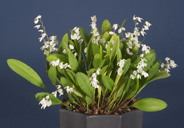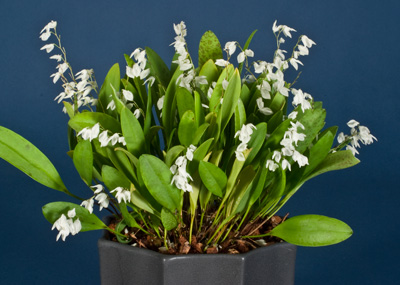
Pleurothallis pterophora
'Stony Point'

Pleurothallis pterophora
by Marni Turkel / Originally Published in Orchids Magazine
by Marni Turkel / Originally Published in Orchids Magazine
| Hybrid Flask List |
| Orchid Programs |
 |
This species is noted for being easy to grow, and because flowers can be produced from a leaf every year for four or five years, it is also floriferous. The inflorescence can be up to 6 inches (15 cm) tall and is slightly longer than the leaves. The flowers, which are held on a zigzag spike, open all at once and last about three weeks. The lateral sepals are fused for nearly their entire length, forming a spoon-shaped structure that is notched at the apex. Winged keels on the back of both the dorsal and lateral sepals give the species its name pterophora (the initial P is silent) which means “bearing wings.”
Pleurothallis pterophora grows as an epiphyte in widely scattered colonies at 2,400 feet (732 m) in the coastal mountains of southeastern Brazil from São Paulo to Espirito Santo. While an intermediate temperature range, with 55 to 60 F (13 to 16 C) minimum nights and 75 to 80 F (24 to 27 C) maximum days, is ideal, it will also grow well under cool conditions with minimum winter nights of 50 F (10 C). Pleurothallis pterophora is an excellent candidate for growing under lights or windowsill culture. As with many species of Pleurothallis, grow it in moderate shade (where a hand held 18 inches (46 cm) above the leaves casts a diffuse shadow) with good humidity and even moisture year round. The plant shown here is growing well in 1/4-inch (6-mm) coconut chunk (well washed to remove excessive salts before using). I have had success using 1/4-inch (6-mm) fir bark mixed with some perlite, tree-fern fiber and charcoal, but any fine-grade epiphytic mix that is open and fast-draining should work well. Fertilize with one-quarter- to one-half-strength fertilizer at every second or third watering in spring and summer and less often in autumn and winter.
For miniature species that flower from the same growth in successive years, it is always a good idea to groom the plants each time they go out of bloom. The old spikes, when dry, are easy to twist off. As I am reminded every year, if you wait until the new spikes are emerging, some of them will inevitably be broken off in the grooming process.
If the leaf tips of Pths. pterophora begin turning brown and papery, there are several things to consider. Poor water quality or over-fertilization are possible causes, but frequently the condition results from an inadequate root mass to support the needs of the plant. Overwatering and bush-snail damage, as well as soggy or stale media will cause the fine roots to die back. The effect on the plant is the same as being underwatered. If the root system is poor, it can take quite some time to get the plant back into good condition. Repot with fresh potting medium into as small a pot as possible and water so that the mix approaches dryness between waterings. When dividing plants of Pths. pterophora, it is my experience that they do best if kept in clumps of at least eight to 10 leaves.
References
Althausen, H. 1954. Collectors’ Item: Pleurothallis pterophora. American Orchid Society Bulletin 23(10):682.
Mostly Species / Orchids and Flasks | Santa Rosa, CA 95407
© Marni Turkel 2003-2022 All rights reserved